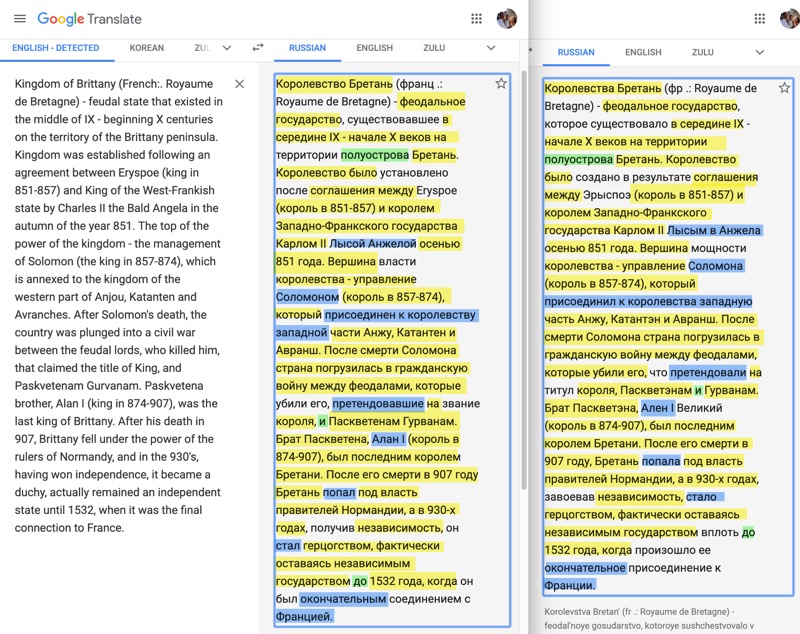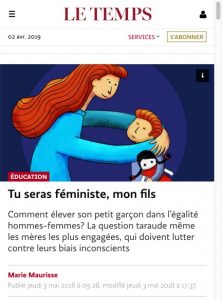How GT Pivots through English
Analysis of the translations of articles such as the sample below demonstrates that Google Translate (GT) uses English as its pivot in almost all cases.
Do not take my word for whether GT pivots through English – try it yourself. Using the method below, the English pivot has been confirmed in dozens of cases where qualified speakers have performed this test for two languages they know. Only Catalan/Spanish, Czech/Slovak, and Korean/Japanese are known to take a different path – they have been mentioned as direct pairs in publications, and confirmed as such in my tests. On this page, I demonstrate the English pivot with a passage from French to German, both among the highest performing languages in the empirical evaluation, and together one of Europe’s most significant pairings. Additionally, the image below shows a graphic comparison of a translation from Belarusian to Russian that leaves little doubt that the text passes through English in their production model, despite Google’s published mention of using a direct path for that pair in recent experiments (Johnson et al 2016).

Comparison of Belarusian->English->Russian (left and center) to direct Belarusian->Russian in Google Translate. Yellow highlights show identical text. Blue highlights show minor spelling variations. Green highlights show the same word but different word ordering. The text was selected by using the random article feature on the Belarusian Wikipedia; the selected article was Каралеўства Брэтань, accessed 28 May, 2019.
The text that GT produces from language A to language B (right hand column in the image above, paragraph 2 in the text below) is virtually identical to the text that is produced by going from language A to English (left hand column in the image above, paragraph 3 in the text below) and then from English to language B (center column in the image above, paragraph 4 in the text below). The similarities between paragraph 3 and paragraph 4 are shown in blue, and the differences are shown in red.
Other than standing the meaning of the second sentence on its head (the fatal error is highlighted in orange, where the English ought to read “that we should”, and this error is passed on to convoluted German and probably the remaining 100 GT languages), the translation from French to English is quite nice at a Bard level. I have no explanation for why the last sentence differs substantially between the two versions, but I have noticed that unusual behaviors often occur at the tail end of translations in GT and DeepL.
Source: Le Temps
Tu seras féministe, mon fils
Marie Maurisse
Publié mercredi 2 mai 2018
1. Original French:
Le débat a été lancé il y a un an aux Etats-Unis, avec un article de Claire Cain Miller paru dans le New York Times. «Désormais, nous savons mieux qu’il faut dire à nos filles qu’elles peuvent devenir ce qu’elles veulent – une astronaute ou une mère, s’habiller en short et baskets ou en robe de princesse. Mais nous ne faisons pas la même chose pour nos fils.» L’auteure donne ensuite une série de conseils concrets pour éviter que son rejeton ne reproduise les stéréotypes de genre: le laisser pleurer lorsqu’il en a envie pour qu’il apprenne à exprimer ses émotions, encourager ses amitiés féminines, ou encore veiller à ce qu’il range sa chambre ou fasse la vaisselle au même titre que sa grande ou sa petite sœur
2. Google Translate from French to English:
The debate was launched a year ago in the United States, with an article by Claire Cain Miller published in the New York Times. “From now on, we know better than to say to our girls that they can become what they want – an astronaut or a mother, to dress in shorts and sneakers or princess dress. But we do not do the same for our sons.” The author then gives a series of concrete tips to prevent her offspring from reproducing gender stereotypes: to let him cry when he feels like learning express their emotions, encourage their female friendships, or make sure that he or she tidies up his room or does the dishes just like his big sister or his little sister
3. Onward GT translation of the previous French to English translation from English to German:
Die Debatte wurde vor einem Jahr in den Vereinigten Staaten mit einem Artikel von Claire Cain Miller in der New York Times veröffentlicht. “Von nun an wissen wir besser, als unseren Mädels zu sagen, dass sie werden können, was sie wollen – ein Astronaut oder eine Mutter, um sich in Shorts und Sneakers oder Prinzessinnenanzügen anzuziehen. Aber wir machen nicht dasselbe für unsere Söhne.” Die Autorin gibt dann eine Reihe konkreter Tipps, um zu verhindern, dass ihr Nachwuchs Geschlechterstereotype reproduziert: ihn weinen zu lassen, wenn er Lust hat zu lernen, Gefühle auszudrücken, Freundinnen zu ermutigen oder dafür zu sorgen, dass er oder sie sein Zimmer aufräumt Gerichte wie seine große Schwester oder seine kleine Schwester
4. Google Translate when French is the source language and German is the target language:
Die Debatte wurde vor einem Jahr in den Vereinigten Staaten mit einem Artikel von Claire Cain Miller in der New York Times veröffentlicht. “Von nun an wissen wir besser, als unseren Mädchen zu sagen, dass sie zu dem werden können, was sie wollen – ein Astronaut oder eine Mutter, um sich in Shorts und Sneakers oder Prinzessinnenanzügen anzuziehen. Aber wir machen nicht dasselbe für unsere Söhne.” Die Autorin gibt dann eine Reihe konkreter Tipps, um zu verhindern, dass ihr Nachwuchs Geschlechterstereotype reproduziert: ihn weinen zu lassen, wenn er es lernen will um ihre Gefühle auszudrücken, um ihre Freundinnen zu ermutigen, oder um sicherzustellen, dass sie ihr Zimmer aufräumen oder den Abwasch machen, genauso wie ihre große Schwester oder Schwester
To notify TYB of a spelling, grammatical, or factual error, or something else that needs fixing, please select the problematic text and press Ctrl+Enter.
![]()
